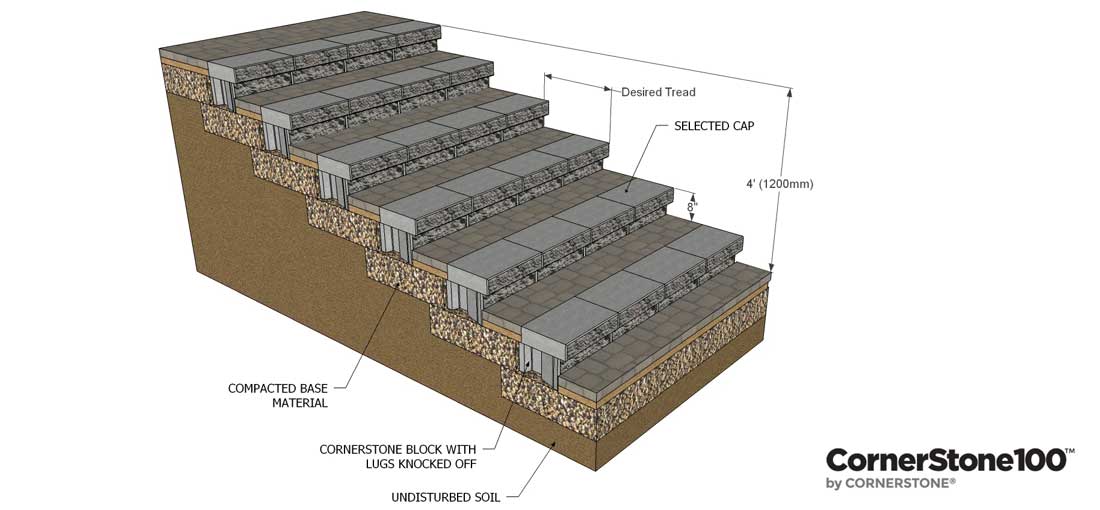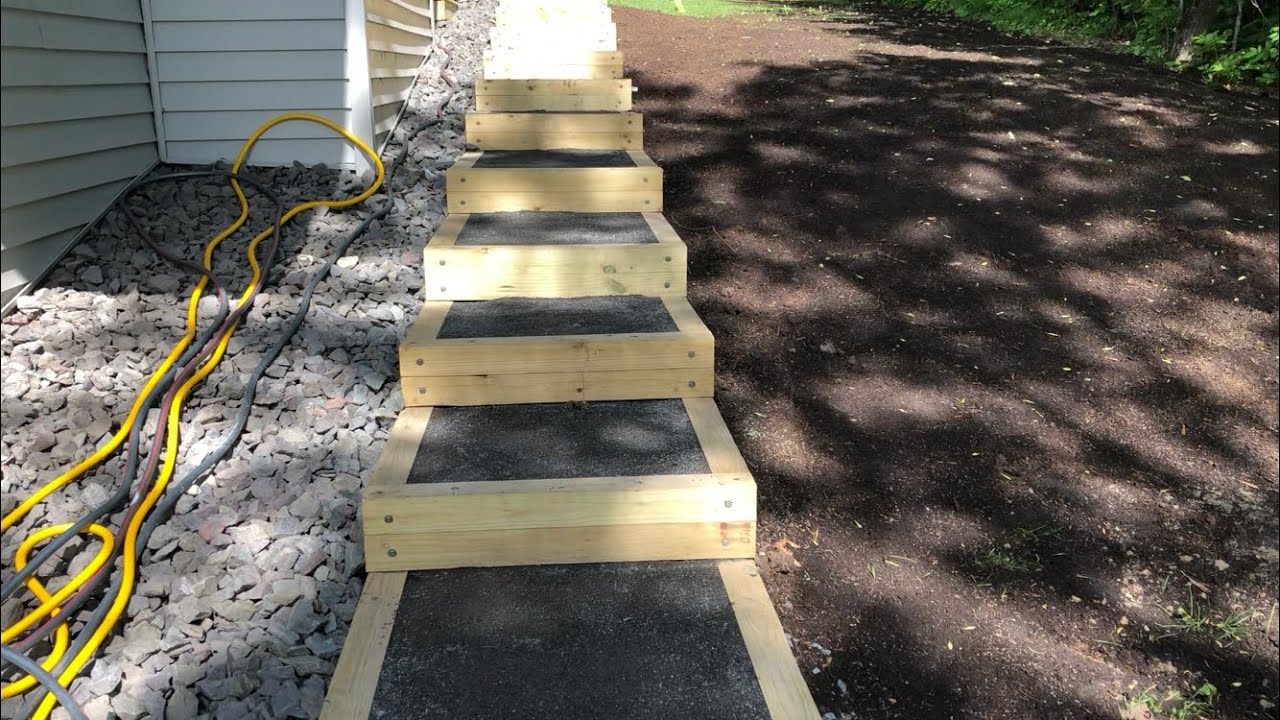To build landscape stairs, you need to plan the design and gather the necessary materials. Once you have the materials, start by leveling the ground and marking the positions of the stairs.
Then, excavate the area and build a base for the stairs using gravel and compacting it. Next, install the risers and treads, ensuring they are securely attached. Finally, finish the stairs with a handrail and apply any desired finishing touches.
Building landscape stairs requires careful planning, preparation, and proper construction techniques to ensure a safe and durable result. If you’re looking to enhance the visual appeal and functionality of your landscape, building stairs can be a great solution. Whether you want to provide better access to different levels of your garden or simply add an interesting architectural feature, landscape stairs can transform the overall look and feel of your outdoor space. However, constructing stairs requires careful planning, precise measurements, and proper construction techniques to ensure safety and longevity. We will guide you through the process of building landscape stairs, from the initial planning stages to the finishing touches, so you can create a stunning and functional addition to your landscape.

Credit: cornerstonewallsolutions.com
How to Build Landscape Stairs : Step by Step Guide
Planning And Preparation
Building landscape stairs requires careful planning and preparation. Evaluating the landscape site is the first step in this process. You need to measure and assess the slope to determine the best approach for constructing the stairs. Additionally, considering safety regulations is crucial to ensure the stairs meet the necessary standards.
By following these guidelines, you can create landscape stairs that are not only visually appealing but also safe for anyone using them. So, take the time to evaluate the site, measure the slope, and consider safety regulations before you begin building your landscape stairs.
Materials And Tools Needed
Landscape stairs can be built by carefully selecting the right materials. To ensure a sturdy and long-lasting structure, it is crucial to choose high-quality materials. Options include natural stones such as granite, limestone, or slate, or treated wood like cedar or redwood.
Additionally, concrete blocks are a popular choice for their durability and affordability. In terms of tools, you will need a tape measure, a level, a shovel, a hand tamper, and a wheelbarrow for mixing concrete if necessary. Optional accessories, like handrails or lighting fixtures, can enhance both the style and functionality of the stairs.
With careful planning and the right materials and tools, you can create beautiful landscape stairs that will withstand the test of time.
Building A Solid Foundation
Building landscape stairs requires a solid foundation. The first step is excavation and leveling the ground. This ensures a flat and stable surface for your stairs. Once the ground is prepared, you can proceed with installing a gravel base. This acts as a stable and draining layer.
With a proper base in place, you can begin constructing the stairs. Remember to carefully follow the measurements and ensure each step is level and secure. Building landscape stairs can be a challenging task, but with the right foundation, you can create a beautiful and functional addition to your outdoor space.
So, roll up your sleeves and get ready to tackle this rewarding project.
Constructing The Stair Frame
Constructing the stair frame involves designing the stair layout, building the step forms, and reinforcing the frame with metal bars. The stair layout should be carefully planned to ensure a safe and functional design. Once the design is in place, the step forms can be built to create the structure of each individual step.
These forms will provide a mold for pouring the materials that make up the stairs. To strengthen the stair frame, metal bars can be added to reinforce the structure and prevent any potential issues with stability or wear. By following these steps, you can successfully build landscape stairs that are sturdy and aesthetically pleasing.
Pouring Concrete Steps
To pour concrete steps, start by mixing the concrete properly. Use a cement mixer or a wheelbarrow to combine the concrete mix with water. Once the concrete is thoroughly mixed, pour it into the forms you have prepared. Fill the forms evenly, making sure there are no gaps or air pockets.
Use a trowel to smooth the surface of the concrete, removing any excess material. Pay attention to the edges and corners, ensuring they are nicely finished. Allow the concrete to set and cure according to the manufacturer’s instructions. Finally, add any desired finishing touches to complete the look of your landscape stairs.
With proper preparation and attention to detail, you can create sturdy and attractive concrete steps for your outdoor space.
Installing Treads And Risers
Installing the treads and risers properly is essential for building landscape stairs. One of the key aspects is choosing durable and aesthetic tread materials. By selecting the right materials, you can ensure that your stairs will withstand the elements and enhance the overall appearance of your landscape.
Securely attaching the steps to the frame is another crucial step in the installation process. This ensures stability and safety for anyone using the stairs. Taking the time to install the treads and risers correctly will result in a long-lasting and visually appealing set of landscape stairs.
So, be sure to carefully follow the necessary guidelines and make informed decisions when it comes to selecting materials and securing the steps to the frame.
Adding Railings And Handrails
Building landscape stairs involves adding railings and handrails to ensure safety. Understanding safety codes and regulations is crucial. Selecting appropriate railing materials plays a significant role in this process. It is essential to install the railings and handrails securely. Following safety standards, you should carefully choose the materials for your railings and handrails.
Consider factors such as durability, weather resistance, and aesthetic appeal. It is also important to identify the appropriate dimensions and design that comply with safety codes and regulations. Once you have selected the materials, proceed with installing the railings and handrails securely.
Make sure they are firmly attached to the stairs and provide proper support. Regularly inspect and maintain the railings to ensure their stability and functionality. By following these guidelines, you can effectively add railings and handrails to your landscape stairs and create a safe environment for everyone.
Enhancing The Stairs’ Appearance And Functionality
Enhancing the aesthetic appeal and functionality of landscape stairs can be achieved through various techniques. One effective approach is applying a decorative finish to the steps. By selecting a unique and visually appealing finish, such as stamped concrete or mosaic tiles, you can instantly transform the look of your stairs.
Additionally, incorporating non-slip features is crucial for ensuring the safety of anyone using the stairs. Adhesive non-slip strips or textured paint can be applied to the surface, providing traction and reducing the risk of slips and falls. Furthermore, integrating lighting elements into the stairs can enhance their usability during nighttime.
LED step lights or solar-powered pathway lights can be strategically placed to illuminate each step, making them more visible and improving overall safety. By considering these enhancements, you can create landscape stairs that are not only visually striking but also functional and safe for everyone.
Regular Maintenance And Troubleshooting Tips
Regular maintenance of landscape stairs is crucial for their longevity and appearance. Cleaning and sealing the steps is an essential part of their upkeep. Start by removing debris and dirt using a stiff brush or power washer. Once clean, apply a high-quality, weather-resistant sealant to protect the stairs from moisture and harsh elements.
Troubleshooting common issues like cracking or chipping involves repairing the damage using a suitable filler or epoxy. Preventive maintenance is key to extending the lifespan of landscape stairs. Regularly inspect for any signs of wear and tear, such as loose or damaged steps, and address them promptly.
Additionally, ensure that the surrounding area is well-maintained to prevent erosion and shifting of the stairs. With proper care and attention, you can build landscape stairs that not only enhance the aesthetics but also provide safe and durable access to different levels of your property.
Frequently Asked Questions Of How To Build Landscape Stairs
How Do You Make Steps Out Of Landscape Timbers?
To make steps out of landscape timbers, follow these steps: 1. Mark the desired location for the steps. 2. Dig a trench and level the ground. 3. Place the landscape timbers in the trench, securing them with rebar or stakes.
4. Backfill the trench with gravel or soil, ensuring the timbers are stable.
How To Build Outdoor Steps?
To build outdoor steps, follow these steps: 1. Measure and mark the location for the steps. 2. Dig out the area and create a level base for the steps. 3. Install a foundation, such as a concrete pad or gravel base.
4. Build the steps using either precast concrete, natural stone, or wood. 5. Secure the steps in place, ensuring they are straight and level. 6. Add handrails for safety, if desired. 7. Finish by landscaping around the steps and ensuring proper drainage.
Remember to always follow building codes and guidelines for your specific area.
How To Build An Outdoor Wood And Gravel Stairs?
To build outdoor wood and gravel stairs, follow these steps: 1. Start by measuring the area and determining the number of steps needed. 2. Clear the ground, removing any plants, rocks, or debris from the area. 3. Dig holes for the stairs’ posts, ensuring they are evenly spaced and at the desired height.
4. Install the posts securely in the ground, using concrete or gravel to stabilize them. 5. Attach stringers to the posts, ensuring they are level and properly aligned. 6. Secure the steps to the stringers, using screws or nails for outdoor wood stairs.
7. Fill the gaps between the steps with gravel, ensuring proper drainage. 8. Finally, add a handrail if desired, to enhance safety and accessibility.
What Is The Best Material For Landscape Steps?
The best material for landscape steps is typically natural stone, such as granite or limestone.
Conclusion
Building landscape stairs can be a challenging and rewarding DIY project for homeowners who want to enhance the functionality and aesthetics of their outdoor spaces. By following the step-by-step guide outlined in this blog post, you can confidently create sturdy and beautiful stairs that blend seamlessly into your landscape.
Start by planning the layout and materials, ensuring proper drainage and leveling, and constructing a solid foundation. Then, proceed to build the stairs, ensuring each step is consistent in size and properly secured. Finally, add finishing touches such as railings and non-slip surfaces for safety.
Remember, when writing content for the web, it is crucial to use SEO techniques to ensure your post reaches a wider audience. By incorporating relevant keywords, providing valuable information, and using concise and engaging language, you can attract readers and improve your website’s ranking on search engine result pages.
So, grab your tools and start building your dream landscape stairs today!

